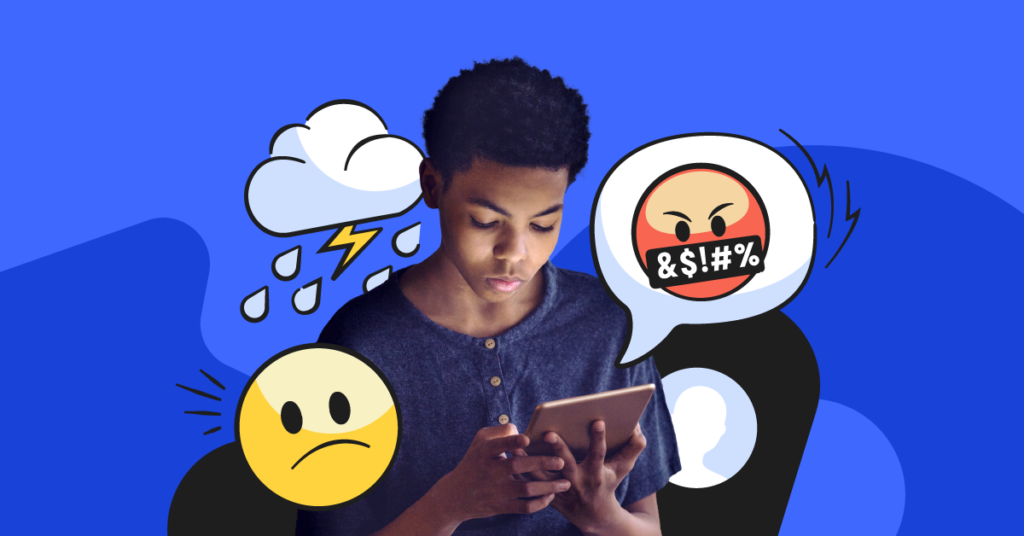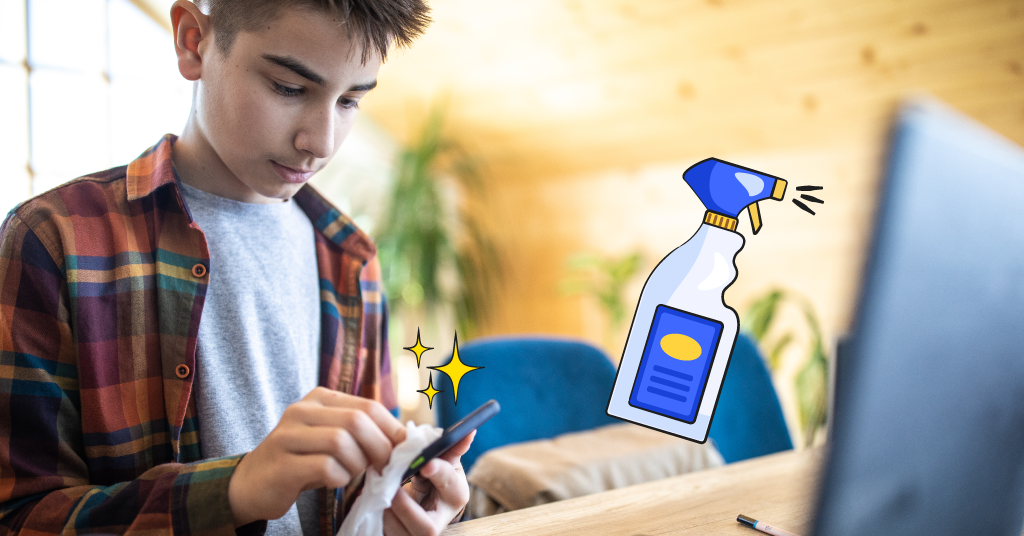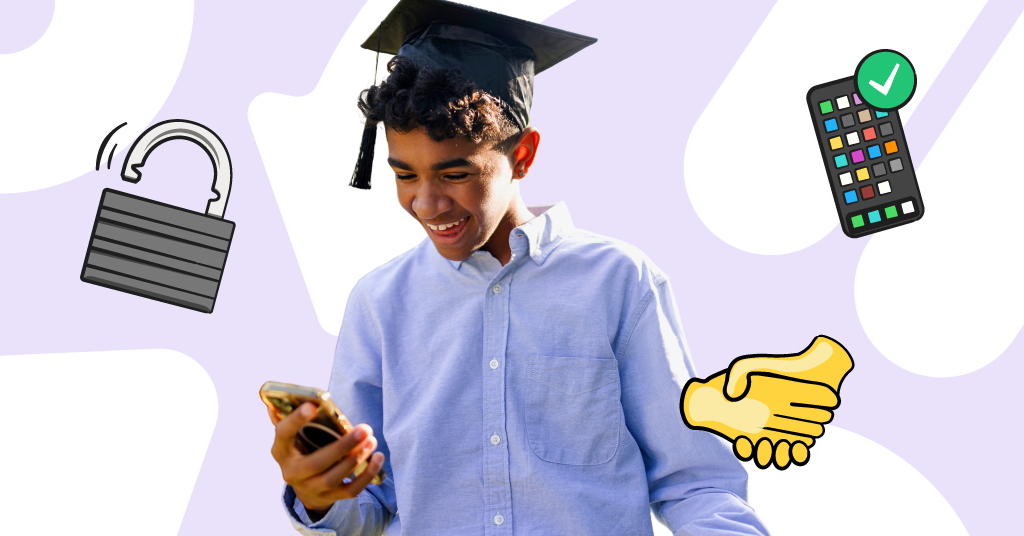
As a parent, you probably want to shield your child from the worst of the world — at least as long as you possibly can. The internet, as you can imagine, complicates things. No matter how hard you filter, block, and monitor, things may still slip through. Friends have phones. Schoolmates have tablets. And, eventually, kids grow up. Striking the right balance between protection and education when it comes to racism on social media is the best way to prepare your child for dealing with this issue for the rest of their life.
Whether your family hasn't had to think seriously about this yet or had to start conversations about race very early, it’s important to stress to children the benefits of fairness, understanding, and kindness. Here at Bark, we believe in the golden rule, and that every family — and every child — deserves a happy, healthy life. In this blog post, we’ll dig into why there’s so much racism on social media, how it affects kids, and how you can talk to your child about this important topic.
Why Is There So Much Racism on Social Media?
Anyone who’s spent time on Facebook and checked out the comments section on a political post is probably familiar with how quickly things can devolve. Even subjects that have nothing to do with race can end up with comments that attack someone’s ethnicity or skin color. But why does this happen so much? There are often a number of factors at work.
People post without thinking
Social media — when combined with the fact that we have little computers that connect us to everyone in the entire world — gives people the chance to post their thoughts as soon as they have them. In situations where emotions run high, it can be easy to immediately dash off an angry response that includes slurs or hateful language. Many times, the response is something that the person would never say in real life to an actual person.
In this way, social media is intensely personal — in that a person’s sense of self can be impacted by a simple comment from a stranger — and also at the same very impersonal, in that it’s easy to forget you’re talking to another living, breathing human being with feelings much like yours.
People can be trolls
In the film The Dark Knight, Alfred responds to Batman’s questioning of the Joker’s insidious motives with the statement, “Some men just want to watch the world burn.” So it can be with internet trolls that exist to rile up others online, and there’s no quicker way to do that than to start attacking physical characteristics and using racist language. They may not even believe what they’re saying — they just know that it can ruin someone’s day in just a few hastily typed-out characters.
People can find community in anger
Racism finds a home online in places where like-minded folks gather to share their hateful thoughts. Reddit, for example, is notorious for allowing hate speech to flourish in its many communities. Members of these communities may join for any number of reasons, including ignorance, powerlessness, prejudice, or a combination of all three.
Social Media And Racism: Why Kids Are Especially Vulnerable
The American Academy of Pediatrics’ position on racism is that it has “significant adverse effects on the individual who receives, commits, and observes racism.” Anger, shame, hate, aggression, and other negative emotions can greatly impact a child's development. Here are a few reasons why kids are especially vulnerable to racism in social media:
They may not understand exactly what they’re doing
Using profanity is often one of the first ways kids try to rebel — and several forms of profanity come from racist slurs or expressions. When a child calls someone a racist bad word, they may not understand the complex history and impact that such a loaded term has.
They might not immediately realize when it’s happening to them
Younger kids especially may find themselves in positions where other children are harassing, ignoring, or shaming them about their background. Some many chalk it up to just being teased or regular schoolyard bullying, but there’s often so much more to it. Cyberbullying can take it to another level when racist memes are created and shared.
What Hate Speech Looks Like
Bark’s 2021 annual report analyzed more than 3.4 billion messages across texts, email, and 30+ apps and social media platforms. When it comes to hate speech, these were the top five platforms with the most instances:
- Kik
- Discord
- Tumblr
- Spotify
- Snapchat
What can we learn from this list? We can see that hate speech occurs online in a wide variety of apps. Kik, Discord, and Snapchat are messaging apps, which means that kids are sharing images and sending text chats that contain inappropriate content. Spotify is a music streaming service, so alerts triggered here indicate that kids are listening to music with potentially racist content. Tumblr is a microblogging platform where images and posts can go viral and be shared by thousands in a matter of hours. Regardless of whether children are actively sharing hate speech, they’re often exposed to it, and the cumulative effect can be damaging.
Social Media And Racism, Real-life Dangers
Social media platforms recognize the impact of racism in social media and are aware of the potential harm it can cause. Community guidelines from Twitter, TikTok, Snapchat, and countless others all contain sections that explicitly ban hate speech. The reason why so many companies strive to keep it off their platforms is because it can lead to real-life violence.
According to Stomp Out Bullying, “Words, name-calling, hateful phrases, casual racist comments — they all have an impact, especially if those words become convincing to a large number of people.” Many times after mass shootings, the perpetrator’s online activities or manifestos point to explicit hate speech.
How to Talk to Your Child About Racism: Conversation Starters
Having a conversation about racism is serious and important, and like all hard talks, can be challenging. It’s so, so important though — try not to shy away from it. Here are some ways to start a conversation with your child in a safe, supportive manner.
Ask for their opinion on a news story concerning racism
Civil rights have been in the news nearly constantly over the past few years. As America reckons with its history, find out what your child has learned and absorbed. If they bring up something you're not familiar with, research it together.
Find out what racism is like at their school
Schools are like microcosms of society, for better or for worse. Ask your child if they’ve ever seen a racist incident in class, witnessed someone use a slur in their presence or online, or even experienced it themselves.
Discuss what it means to be an “upstander”
Upstanding is the opposite of bystanding — or sitting back while something unfair happens. Here are a few ways to get your child involved in upstanding. Make sure they know they can always:
- Tell the person to stop
- Get others to join them by standing up to the person bullying
- Shift focus away from the person bullying
- Find an adult who can help
How to talk to your child if they experience racism
Not all children will experience racism on social media. But for families who do, Dr. Sadiqa Cash wrote an article for Texas Children’s Hospital on how to develop resilience in children in the face of racism:
- Affirm their identity. Teach your child to take pride in their background and culture. It’s worth celebrating!
- Surround them with representation. Every kid deserves to see themselves as doctors, baseball players, superheroes, attorneys, and more. Find books, TV shows, movies, etc. featuring people who look like your child.
- Validate their feelings. Speak openly and honestly with your kid about the reality of racism in our society. Let them know that whatever they’re feeling is okay, and support them as much as you can.
- Find community. It takes a village to raise a child. Find community organizations that help your child feel at home and thrive.
Fighting Prejudice with Purposeful Inclusion
Most of the values children learn come from their families, from table manners to thoughts on TV shows. Even if your family never discusses race, a stance is being taken — silence on important matters can speak volumes. It can also create a vacuum that outside influences may fill, often to a child’s detriment. Need some ways to help raise an anti-racist kid? Try these:
- Expose your child to other cultures and praise different perspectives. This can be as easy as watching a movie set in a different country, like Coco.
- Set a real-life example by having friends from different backgrounds.
- Denounce racist behavior shown on the news to help communicate to your child that racist actions are not to be emulated.
- Avoid race-based cliches and stereotypes whenever talking about people, music, movies, and more.
Why It’s Important to Protect Your Child Online
Bark can help you protect your kid from racism on social media. Our award-winning service gives parents peace of mind by monitoring texts and 30+ apps for signs of bullying, hate speech, suicidal ideation, and more.
These alerts not only help keep your child safe, they also spur important discussions about the topic — even if your child is just a witness to something inappropriate in a group chat or on YouTube. The internet can be a scary place. Let Bark help support your family as you navigate it.
Read more
Bark helps families manage and protect their children’s digital lives.





